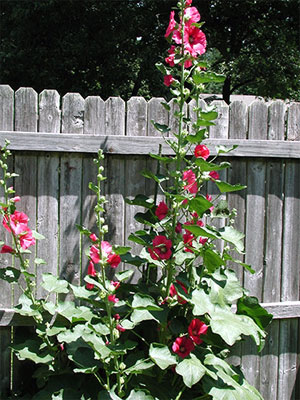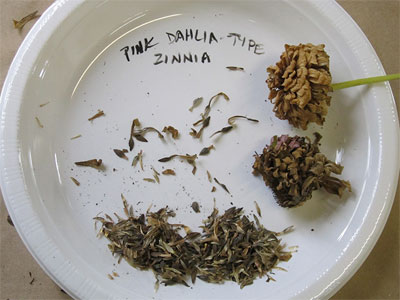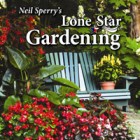From the Magazine
Save the Seeds
New enthusiasts, like our forebears,
collect and store heirloom seeds

Hollyhocks, like these old-fashioned beauties, grew in Thomas Jefferson’s Monticello garden and have been saved for posterity by avid seed savers. All photos by Mary Wilhite.
For thousands of years, since humans developed an agrarian society, farmers and gardeners have collected and shared seeds. The practice of seed saving has a long and economically valuable history. Seeds of food crops, seasonings and medicinal plants had great worth and were carefully transported throughout the world. Immigrants often carried seeds of native plants when they moved to a new country. The many novel plants European explorers discovered in the New World became important trading products, but it was difficult to transport living plants. Collecting and storing seeds was the easiest way of conveying these precious commodities.
As plants cross-pollinated and growers picked and chose their favorite plants for seed collection, there developed an immense variety of vegetables, fruits, flowers, trees and shrubs. In the last 60 years, farmers and gardeners have come to rely on commercial seed companies for their seed supply. These for-profit companies concentrate on crops that hold the greatest economic potential and broadest appeal. The companies also realize greater profitability from patented hybrid seed over older, open-pollinated seed, which limits the number of varieties they offer for sale. That means that thousands of varieties of native and heirloom plants were lost in the last half of the 20th century.
A strong grass roots movement has sprung up to save heirloom and ethnic plants from extinction. The movement attracts botanists, agronomists, organic farmers, native plant enthusiasts and gardeners interested in ensuring genetic diversity in modern plants.
Many people start seed saving as a way to preserve plants that have been passed on to them and are not available in the retail market. Flowers and vegetables that have fallen out of fashion and been dropped from commercial production have been kept alive by gardeners who took the trouble to properly collect and store the seed, cultivating the plants in their own gardens and sharing seed with others.
You can participate in this valuable endeavor and start a rewarding new hobby. Seed collecting is enjoyable and interesting, and it will help you become better acquainted with your garden favorites.
How to Collect and Process Seed
Collect seeds from open-pollinated plants. Seeds from hybrids produce strange offspring with characteristics different from their parents. Growing more than one variety of a species can lead to cross-pollination, so cultivate only one variety, or physically separate plants with the same Latin name to preserve the plant’s unique genetics.

It is important that seeds dry completely before storing. Seeds from these zinnia heads will be spread on the plate and left to dry.
Gather seeds from plants that are strong, healthy and attractive. Let the seeds mature and ripen on the plants. Pods will brown and shrivel slightly, and flower heads will begin to fall apart and darken in color when fully mature. Remove seeds from pods and break apart the seedheads, then spread the seeds out to dry.
For fruits and vegetables, harvest at the height of ripeness for fully mature seeds. Tomato, cucumber, squash, melon and pumpkin seeds need fermentation before drying. Scoop seeds from the vege-tables, place them in a large jar or bowl, and cover with water. Let stand at room temperature for about three days. When fermentation begins, mold will form on the surface of the water. Add more water and stir, then skim the mold and debris off the top of the water. Repeat this process until the water is mostly clear and clean seeds remain on the bottom of the container. Strain off the water and dry the seeds on newspaper or paper plates.
Storing Seed
Seeds must be completely dry before storing. You can check this by bending a seed — when it breaks instead of bends, it is thoroughly dry. Store seeds in airtight containers with labels clearly showing the plant name (or description) and the date. Keep the container in a cool, dark location — the refrigerator works well. Try to use the seeds (or pass them along to another lucky gardener) within one year.
Join the ranks of naturalists working to protect diversity in the plant world by cultivating, then saving and trading seeds from heirloom and native plants.
About the author: Mary Wilhite is co-owner of Blue Moon Gardens, a retail nursery and garden center in Chandler (www.bluemoongardens.com).

